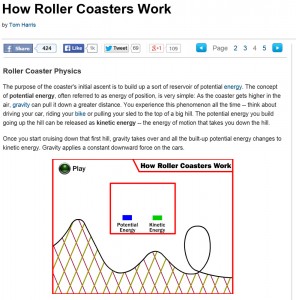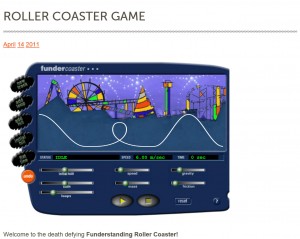3. Elicitation
Part One: Designing Your Roller Coaster Using Physics Concepts
In general, wooden coasters are nonlooping. They’re also not as tall and not as fast as steel coasters, and they don’t feature very steep hills or as long a track. Wooden coasters do offer one advantage over steel coasters: they sway a lot more. Some design elements to keep in mind are the shape of the coaster (as this determines the angles of decent), and height of the first drop (as this determines the speed of the train).
The Shape of the Coaster
Roller coasters are like projectiles that moves through space. A parabolic hill is a particularly special kind of coaster hill. When the train goes over such a hill, it, and its riders, briefly undergo free fall. In this case, the train may literally not be touching the track at all. Because, neglecting air resistance, all bodies fall at the same rate (another fact known to Galileo), the riders will fall in synchronization with the train. No part of the train will exert any force on the rider; the only force involved is gravity. In a sense, the rider is actually flying, because he or she is taking the same path as if there were no train or track there at all. Furthermore, the smooth curves will keep the train on its track and offer riders a safe ride.
Height of the First Drop
The amount of energy the coaster has to complete its journey around the track depends on the potential energy it has due to its height at the beginning. Roller coasters are called “gravity rides” for a good reason: once the coaster has been dragged to the top of the first hill and released, it is the force of gravity that keeps the coaster going all the way back to the station platform at the end of the ride. As the coaster goes through its twists, turns, rolls, and loops, it converts its initial potential energy (supplied by dragging it up the first hill). Energy changes from potential into kinetic energy and back into potential energy. Since some of this initial energy is lost due to friction, the roller coaster can never rise as high as the first hill and there is a relationship between the height of this hill and the speed of the coaster. The higher the height of the coaster, the more potential energy the ride has which means more energy can be converted into kinetic energy (controls the speed of the train) at the bottom of the hill. This relationship is further explained at the following link
http://science.howstuffworks.com/engineering/structural/roller-coaster3.htm
Experiment
To get a better idea of designing a roller coaster, play around with the following interactive sites:
http://www.learner.org/interactives/parkphysics/ http://www.funderstanding.com/coaster/



